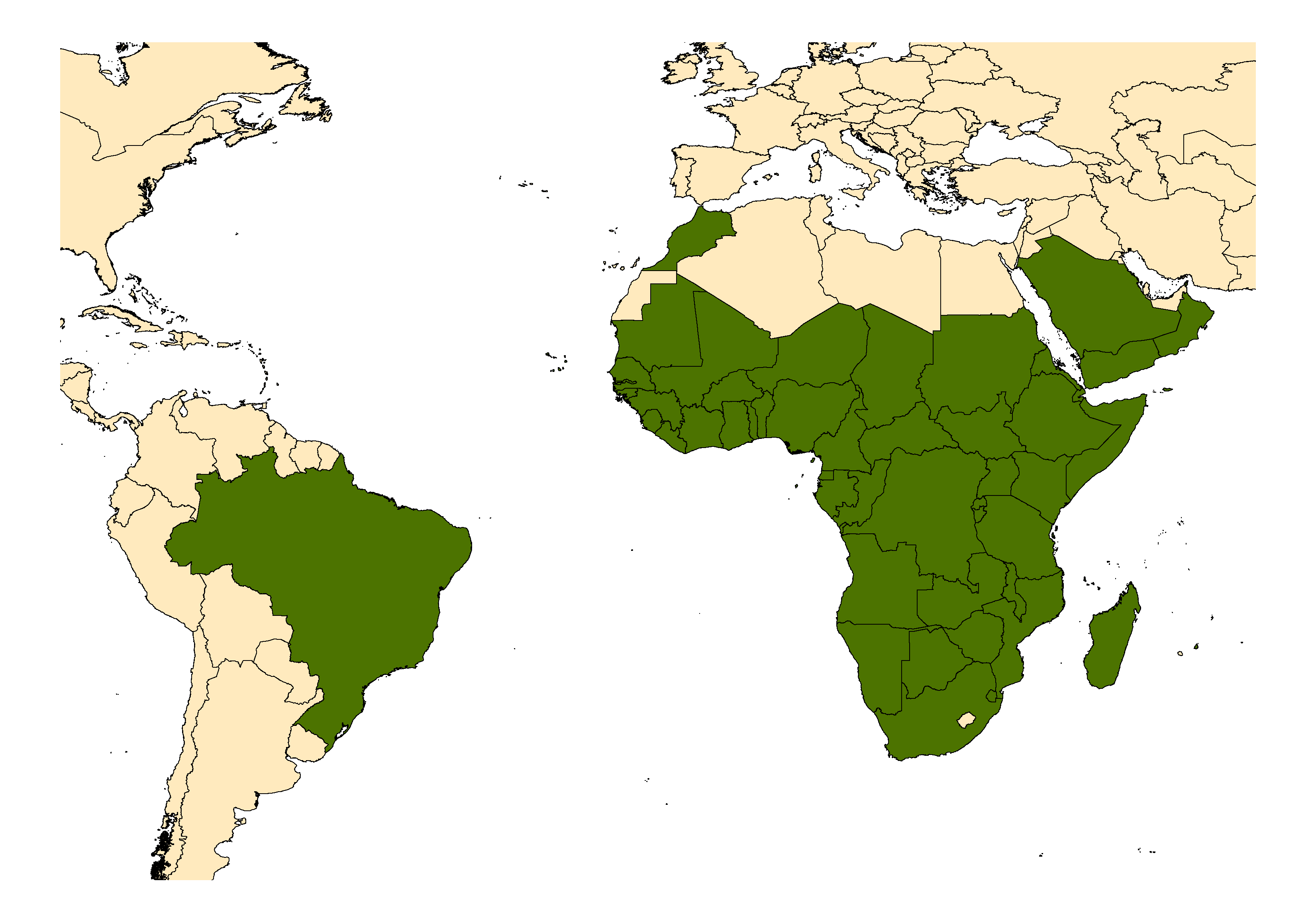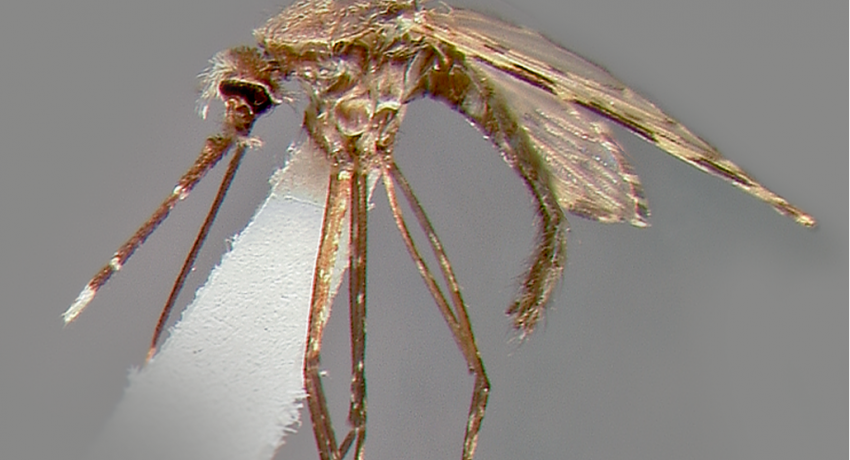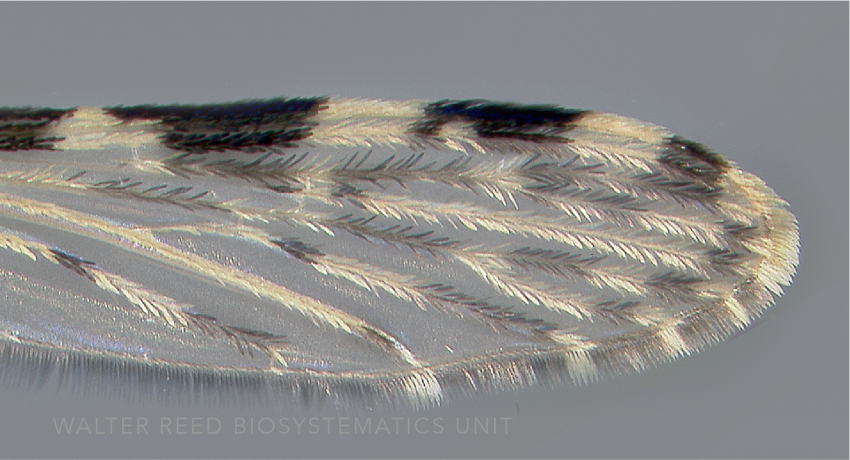AFROTROPICAL & ARABIAN PENINSULA REGIONS
Etymology: Gambia Valley, West Africa
Anopheles gambiae is the nominotypical member of the infamous Gambiae Complex, and the most effective Afrotropical vector of cerebral malaria. Anopheles gambiae has four valid species synonyms—costalis Giles, gracilis Dönitz, minor Holstein and typicus Holstein). The status of two chromosomally distinct (but essentially isomorphic) forms of An. gambiae—Mopti (M) and Savanna (S)—were recently clarified with the formal description of Anopheles coluzzii Coetzee & Wilkerson (=M form), which are isomorphic except in the egg stage. The Gambiae Complex now includes An. amharicus Hunt, Wilkerson & Coetzee (formerly An. quadriannulatus B), An. arabiensis Patton, An. bwambae White, An. coluzzii, An. gambiae, An. melas Theobald, An. merus Dönitz and An. quadriannulatus (Theobald). The taxonomic status of three other reported chromosomal forms of An. gambiae (Bamako, Forest and Bissau) remain unresolved.
Type locality: Gambia Valley, West Africa [Gambia]
Type depository: Natural History Museum, London, England, United Kingdom (NHMUK)
DIAGNOSTIC CHARACTERS (Click photos to view; mouse over and click large photo to zoom in.)
ADULT (illustrated): Head: Palpus usually with 3 pale bands. Legs: Ta-III1-5 not entirely pale; legs sparsely speckled. Wing: Costa and veins R–R1 with ≥4 dark spots; preapical dark spot on vein R1 with or without pale interruption; wing with pale fringe spots up to CuA or 1A. Abdomen: Abdomen without posterolateral scale tufts; sparse or no dorsal abdominal scales.
LARVA (not illustrated): Head: Seta 1-A very small; seta 2-C single or aciculate, aciculae can be long; seta 2-C widely separated > than distance between 2-C and 3-C; seta 3-C single or ≤8-branched. Thorax: Seta 1-P not well-developed, basal tubercle absent or small; setae 9,10-M usually single; spine at base of setae 9-12-M distinct, curved and sharply pointed; Abdomen: Seta 1 palmate on all or most segments; segment V with tergal plate small (0.67 x distance between palmate setae); no spicules on sides of larval thorax and abdomen.
TAXONOMIC KEYS
Deane, L.M. et al. 1946
Causey et al. 1946
Deane, M.P. et al. 1946
Becker et al. 2010
![]()
WRBU - Anopheles - Afrotropical Region - Larva
![]()
WRBU - Genera - Global - Adult
![]()
WRBU - Genera - Global - Larva
![]()
WRBU - Genera - Afrotropical - Adult
![]()
WRBU - Genera - Afrotropical - Larva
Exemplar DNA sequences
An. gambiae whole genome: AAAB00000000.1
An. amharicus ITS2: GQ870316;
An. arabiensis whole genome: GCA_000349185.1
An. bwambae whole genome: GCA_007018985.1
An. coluzzii whole genome: ABKP00000000.2
An. melas whole genome: GCA_000473525.2
An. merus whole genome: GCA_000473845.2
An. quadriannulatus whole genome: GCA_000349065.1
BIONOMICS
Immatures
The immature habitats of both An. gambiae and An. coluzzii are associated with human activities and dwellings, especially in areas affected by human activities, such as deforestation, road making, and veld burning. Immature An. gambiae s.s. are associated with temporary, rain-dependent habitats including ground pools, quarries, puddles, wheel ruts and hoofprints, where as An. coluzzii tends to occupy slightly larger water bodies associated with agriculture, including rice fields, ditches and reservoirs.
Adults
Both An. gambiae and An. coluzzii are highly anthropophilic, feeding primarily on people. Both An. gambiae s.s. and An. coluzzii are highly effective malaria vectors. Both species were collected on sticky traps posted on balloons at high altitudes (40–240m) over the Sahel Region, indicating that blood fed females undertake long-distance migrations (up to 350km) to avoid harsh desert conditions, potentially arriving into new destinations already infected and capable of transmitting malaria.
DISTRIBUTION NOTES
Angola, Benin, Botswana, Brazil, Burkina Faso, Burundi, Cameroon, Cape Verde, Central African Republic, Chad, Comoros, Congo, Côte d'Ivoire, Democratic Republic of the Congo, Djibouti, Equatorial Guinea, Eritrea, Eswatini, Ethiopia, Gabon, Gambia, Ghana, Guinea, Guinea Bissau, Kenya, Liberia, Madagascar (includes Glorioso & Juan De Nova Is), Malawi, Mali, Mauritania, Mauritius, Mayotte, Morocco, Mozambique, Namibia, Niger, Nigeria, Oman, Republic of South Africa, Rwanda, São Tomé & Príncipe, Saudi Arabia, Senegal, Seychelles, Sierra Leone, Somalia, Sudan & South Sudan, Swaziland, Tanzania, Togo, Uganda, Yemen, Zambia, Zimbabwe.

WRBU VECTOR HAZARD REPORTS
View other WRBU Vector Hazard Reports
Available GIS Models
An_gambiae s.l._Nyari_1 Africa
IMPORTANT REFERENCES (full citations below)
Giles 1902: 511 (F)
Theobald 1903c: 2 (as gambiensis, lapsus)
Macfie & Ingram 1922 (F*; as costalis Theobald)
Séguy 1924: 161 (L*), as costalis
Evans 1938: 299 (M*, F*, P*, L*, E*; bionomics)
Causey et al. 1943a (bionomics; sensu lato)
Deane, L.M. et al. 1946 (F*, key, bionomics; NE Brazil & Amazonas; sensu lato)
Causey et al. 1946 (M*, key; NE Brazil & Amazonas; sensu lato)
Deane, M.P. et al. 1946 (L*, key, bionomics; NE Brazil & Amazonas; sensu lato)
De Meillon 1947b: 190 (M*, F*, L*, E*; bionomics)
Horsfall 1955: 223 (review)
Coluzzi 1964: 197 (taxonomy)
Chauvet & Dejardin 1968: 69 (L)
Gillies & De Meillon 1968: 208 (M*, F*, P*, L*, E*; bionomics)
Chauvet et al. 1969: 51 (taxonomy; Gambiae Complex)
Service 1970b: 131 (taxonomy)
Green 1971: 421 (taxonomy)
White & Muniss 1972: 793 (taxonomy)
Davidson & Hunt 1973: 121 (Gambiae Complex)
Reid 1973: 87 (taxonomy)
White 1973: 249 (cytogenetics, taxonomy; species D)
Reid 1975a (taxonomy)
Reid 1975b: 299 (pupal differentiation of species A & B)
White 1975: 313 (taxonomy)
Mahon et al. 1976: 25 (molecular taxonomy; Gambiae Complex)
Gatti et al. 1977: 105 (molecular taxonomy; Gambiae Complex)
Mattingly 1977: 323 (Gambiae Complex)
Sinka et al. 2010: 117 (bionomics review, distribution, niche model)
Becker et al. 2010: 323 (sensu lato; F*; key, taxonomy, distribution, bionomics)
Becker et al. 2010: 324 (sensu stricto ; F*, L*; taxonomy, distribution, bionomics)
Ahmed et al. 2011 (distribution; Saudi Arabia)
Lanzaro & Lee 2013 (bionomics, genetics; Gambiae Complex)
Crawford et al. 2016 (molecular taxonomy; sensu lato)
Kyalo et al. 2017 (distribution; sub-Saharan Africa; as sensu lato & sensu stricto)
CURRENT SYNONYMS
syn. costalis Giles
1900b: 49 (M*, F*; not Loew, 1866). Type locality: West Coast of Africa (NHMUK). References: Mattingly 1977: 323 (taxonomy).
syn. gracilis Dönitz
1902: 76 (M*, F). Type locality: Togo & Kamerun [Cameroon] (NE).
syn. minor Holstein
1949: 156 (F). Type locality: Koua, Haute Volta [Burkina Faso] (NE).
syn. typicus Holstein
1949: 156 (F). Type locality: Koua, Haute Volta [Burkina Faso] (NE).
CITED REFERENCES
Ahmed, A.M., Shaalan, E.A., Aboul-Soud, M.A.M., Tripet, F., & Al-Khedhairy, A.A. (2011). Mosquito vectors survey in the Al-Ahsaa district of eastern Saudi Arabia. Journal of Insect Science, 11, 176.
Becker, N., Petrić, D., Zgomba, M., Boase, C., Madon, M., Dahl, C., & Kaiser, A. (2010). Mosquitoes and their control (Second ed.). Berlin Heidelberg: Springer-Verlag.
Causey, O.R., Deane, L.M., & Deane, M.P. (1943a). Ecology of Anopheles gambiae in Brazil. American Journal of Tropical Medicine, 23(1), 73–94.
Causey, O.R., Deane, L.M., & Deane, M.P. (1946). An illustrated key by male genitalic characteristics for the identification of thirty-four species of Anophelini from the northeast and Amazon regions of Brazil, with a note on dissection technique. American Journal of Hygiene Monograph Series, 18, 21–31.
Chauvet, G., & Dejardin, J. (1968). Caractères chetotaxiques de distinction entre larves (stade IV) de l'espèce A et de l'espèce B du complexe Anophèle gambiae à Madagascar. Cahiers O.R.S.T.O.M, (Office de la Recherche Scientifique et Technique Outre-Mer) Série Entomologie Médicale, 6(1), 69–101.
Chauvet, G., Davidson, G., & Dejardin, J. (1969). Validite d'une methode chetotaxique de distinction des larves des espèces A et B du complexe Anopheles gambiae Giles a Madagascar. Cahier ORSTOM. Série Entomologie Médicale, 7(1), 51–60.
Coluzzi, M. (1964). Morphological divergences in the Anopheles gambiae complex. Rivista di Malariologia, 43(4–6), 197–232.
Crawford, J.E., Riehle, M.M., Markianos, K., Bischoff, E., Guelbeogo, W.M., Gneme, A., . . . Lazzaro, B.P. (2016). Evolution of GOUNDRY, a cryptic subgroup of Anopheles gambiae s.l., and its impact on susceptibility to Plasmodium infection. Molecular Ecology, 25(7), 1494–1510.
Davidson, G., & Hunt, R.H. (1973). The crossing and chromosome characteristics of a new, sixth species in the Anopheles gambiae complex. Parassitologia, 15(1–2), 121–128.
De Meillon, B. (1947b). The Anophelini of the Ethiopian geographical region. Publications of the South African Institute for Medical Research, 10(49), 1–272.
Deane, L.M., Causey, O.R., & Deane, M.P. (1946). I. An illustrated key by adult female characteristics for the identification of thirty-five species of Anophelini, with notes on the malaria vectors (Diptera, Culicidae). In Studies on Brazilian anophelines from the northeast and Amazon regions (pp. 1–18). Baltimore: The Johns Hopkins Press.
Deane, M.P., Causey, O. R., & Deane, L.M. (1946). III. An illustrated key by larval characteristics for the identification of thirty-two species of Anophelini, with descriptions of two larvae. In Studies on Brazilian anophelines from the northeast and Amazon regions (pp. 33–50). Baltimore: The Johns Hopkins Press.
Dönitz, W. (1902). Beitrage zur Kenntniss der Anopheles. Zeitschrift fur Hygiene, 41, 15–88.
Evans, A.M. (1938). Mosquitoes of the Ethiopian Region. II. Anophelini adults and early stages. London: British Museum (Natural History).
Gatti, M., Santinl, G., Pimpinelli, S., & Coluzzi, M. (1977). Fluorescence banding techniques in the identification of sibling species of the Anopheles gambiae complex. Heredity, 38(1), 105–108.
Giles, G.M. (1900b). Description of two species of Anopheles from West Africa. Liverpool School of Tropical Medicine Memoir, 2, 49–51.
Giles, G.M. (1902). A handbook of the gnats or mosquitoes giving the anatomy and life history of the Culicidae, together with descriptions of all species notices up to the present date. J. Bale, sons & Danielsson, Limited, London, 530pp.
Gillies, M.T., & de Meillon, B. (1968). The Anophelinae of Africa, south of the Sahara (Ethiopian zoogeographical region). Publications of the South African Institute for Medical Research, 54, 1–343.
Green, C.A. (1971). The practical problem of identifying members of the Anopheles gambiae complex in autecological studies. Parassitologia, 421–427.
Hay, S.I., Sinka, M.E., Okara, R.M., Kabaria, C.W., Mbithi, P.M., Tago, C.C., …Godfray, H.C.J. (2010). Developing global maps of the dominant Anopheles vectors of human malaria. PLoS Medicine, 7(2): e1000209.
Holstein, M.H. (1949). Le problème d'Anopheles gambiae. Bul Med AOF, 155–160.
Horsfall, W.R. (1955). Mosquitoes. Their bionomics and relation to disease. New York, NY: Hafner Publishing Company. (Reprinted 1972).
Kyalo, D., Amratia, P., Mundia, C.W., Mbogo, C.M., Coetzee, M., & Snow, R.W. (2017). A geo-coded inventory of anophelines in the Afrotropical Region south of the Sahara: 1898–2016. Wellcome Open Research, 2, 57.
Lanzaro, G.C., & Lee, Y. (2013). Speciation in Anopheles gambiae — The distribution of genetic polymorphism and patterns of reproductive isolation among natural populations. In S. Manguin (Ed.), Anopheles mosquitoes - New insights into malaria vectors (pp. 173–196). Janeza Trdine 9, 51000 Rijeka, Croatia: InTech.
Macfie, J.W.S., & Ingram, A. (1922). On the genital armature of the female mosquito. Annals of Tropical Medicine and Parasitology, 16, 157–188.
Mahon, R. J., Green, C.A., & Hunt, R.H. (1976). Diagnostic allozymes for routine identification of adults of the Anopheles gambiae complex (Diptera, Culicidae). Bulletin of Entomological Research, 66(1), 25–31.
Mattingly, P.F. (1977). Names for the Anopheles gambiae complex. Mosquito Systematics, 9(3), 323–328.
Reid, J.A. (1973). Larval differences between sympatric populations from Kaduna, West Africa, of species A and B of the Anopheles gambiae group. Parassitologia, 15, 87–98.
Reid, J.A. (1975a). Pupal differences between species A and B of the Anopheles gambiae group from Kisumu, East Africa. Mosquito Systematics, 7(1), 1–7.
Reid, J.A. (1975b). Pupal differences between species A and B of the Anopheles gambiae group from Kaduna, West Africa. Mosquito Systematics, 7(4), 299–302.
Séguy, E. (1924). Les moustiques de l'Afrique Mineure, de l'Egypte et de la Syrie. Encyclopedie Entomologique (A), 1, 1–257.
Service, M.W. (1970b). Identification of the Anopheles gambiae complex in Nigeria by larval and adult chromosomes. Annals of Tropical Medicine and Parasitology, 64, 131–136.
Theobald, F.V. (1903c). Report on a collection of mosquitoes or Culicidae, etc., from Gambia, and descriptions of new species. Liverpool School of Tropical Medicine Memoir, 10.
White, G.B. (1973). Cytogenetics, systematics and importance of Anopheles gambiae species. D. 9th International Congress of Tropical Medicine and Malaria (Athens), 9(1), 249–250.
White, G.B. (1975). Notes on a catalogue of the Ethiopian Region. Mosquito Systematics, 7(4), 303–344.
White, G.B., & Muniss, J.N. (1972). Taxonomic value of spermatheca size for distinguishing four members of the Anopheles gambiae complex in East Africa. WHO Bulletin, 46, 793–799.
CITE THIS PAGE
Walter Reed Biosystematics Unit (Year). Anopheles gambiae species page. Walter Reed Biosystematics Unit Website, http://wrbu.si.edu/vectorspecies/mosquitoes/gambiae, accessed on [date (e.g. 03 February 2020) when you last viewed the site].










































































































































































